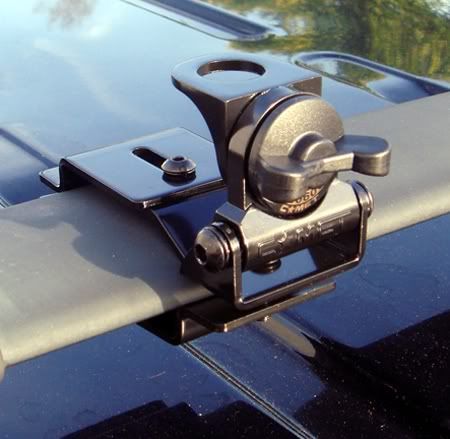thethinginthewoods
Adventurer
Having just recieved my first technician HAM license (KF7TBF), I managed to acquire a Kenwood TM-D710a dual band 2m/70cm radio and a Larsen NMO 2/70B antenna as an early Christmas gift and I plan on installing them on my 2000 Jeep Cherokee (XJ). I have done a lot of research regarding ground planes and mounting options for CB and HAM antennas, but still have a few questions...
The dilemma I am faced with is trying to work around my roof rack. I know mobile antennas and roof racks don't play nicely together, but I am not willing to part with my roof rack. I currently have a basic yakima rack, consisting of an arrangement of tubular powder-coated bars that attach to the factory cross-bars with padded plastic clamps. I am not concerned about antenna height, as I have another Jeep for my serious trail-work in the forest.
I would prefer to mount the antenna with a mount similar to this:

However, this means the antenna would be raised about 3-6" off the roof, reducing the effectiveness of the metal roof acting as the counterpoise. Would a simple ground strap from the base of the mount to a metal part of the roof solve this issue? If not, would mounting via an NMO through the roof and having the antenna stick up between the bars of the roof rack cause problems/interference with the radiating waveform from the antenna?
I've also considered constructing a mesh floor for the rack to work as a groundplane...
Suggestions? Comments?
Any help is greatly appreciated!
The dilemma I am faced with is trying to work around my roof rack. I know mobile antennas and roof racks don't play nicely together, but I am not willing to part with my roof rack. I currently have a basic yakima rack, consisting of an arrangement of tubular powder-coated bars that attach to the factory cross-bars with padded plastic clamps. I am not concerned about antenna height, as I have another Jeep for my serious trail-work in the forest.
I would prefer to mount the antenna with a mount similar to this:

However, this means the antenna would be raised about 3-6" off the roof, reducing the effectiveness of the metal roof acting as the counterpoise. Would a simple ground strap from the base of the mount to a metal part of the roof solve this issue? If not, would mounting via an NMO through the roof and having the antenna stick up between the bars of the roof rack cause problems/interference with the radiating waveform from the antenna?
I've also considered constructing a mesh floor for the rack to work as a groundplane...
Suggestions? Comments?
Any help is greatly appreciated!
